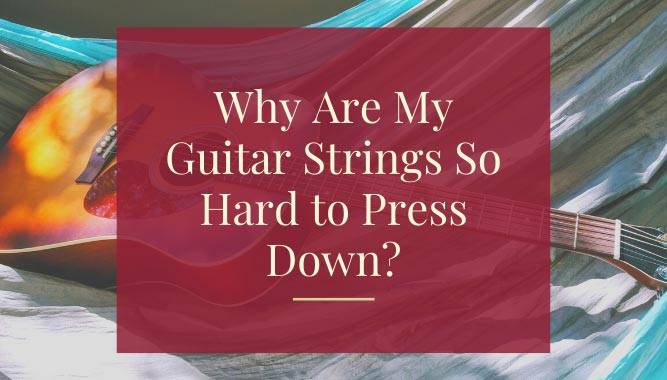Last Updated on January 3, 2025 1:38 am
While I was playing my guitar, I feel my guitar strings were so hard to press down. After that, I did depth research on the internet to solve my problem but couldn’t found much. So, I decided to explain the details here on how I solved the issue.
The guitar is quite a common and popular string instrument. Even after being played for decades, it entirely hasn’t lost its charm and continues to attract people of all ages to give it a try as a hobby or even for a living. Now people playing an instrument often see their investment and want to take good care of it. Hence this article is dedicated to one of the most common problems faced when playing or learning guitar.
When it comes to instruments—particularly stringed instruments—one of the essential contemplations for the musician is how the instrument plays. In technical parlance, this is commonly denoted as an instrument’s action. In this article, we’ll be talking about guitar action.
Why is my Guitar Strings so hard to press down? Well, there can be many reasons why it is happening, but one of the most common reasons why this might be happening is the cause of higher GUITAR ACTION. Guitar action on a guitar refers to the height of the strings above the fretboard. Guitar action plays an essential role in how a guitar feels when playing.
If the action is higher than it should be, the guitar will feel painful to play. If the action is too low, you will perceive the strings buzzing. Guitar action is imperative to get right because it can completely change how a guitar feels while playing.
If your guitar’s action is too high, your fingers need to push the strings down certainly far before they come into contact with the strings. It can make it awkward to play and makes the strings hard to press down, which can lead to painful sessions.
Higher Action Problems and Ways to Solve Them:
To know this, first of all, you have to understand that a guitar having guitar action tends to sound a lot more open. The main reason behind this the distance between the strings and the individual fret. It leads to the sound to resonate without coming in contact with any other fret fully. When you have guitar action, the press to make a note should be harder. Although pulling off a hammer-on or sweep picking would rather be very difficult to try on a high action guitar.
Let’s have a look at some great tips that will help you play your guitar smoothly.
01. Does lowering the action help
Though lower the action, it’ll be rather easy for you to push the string down to the fret too low action can also cause the fret to buzz, and that won’t be a pleasant sound to the ears.
Lowering the action could help remedy the issue, and that can be accomplished by altering the saddles and the bridge until the preferred action (low, medium, high) is reached.
02. Measurement of Action
Action is determined by measuring the distance from the peak of the 12th fret to the bottoms of the string. A right starting action will be 9.5; beginners can go lower than this to make it easy for playing. One can further lower the action by adjusting the saddles and the bridge until the desired action is reached.
However, changing the action of the guitar can cause an overall change in the entire setup of the guitar, so one must adapt accordingly.
03. Tension on the string
Of course, the quality of a string in a string instrument has a more significant effect on the instrument as a whole. The tension of the string has variables like: how long is the string? Cause longer the string more the tension for the pitch and gauge. Heavier gauges lead to more tension as well if one wants to make it easier to use to press down the strings quickly.
04. The surface area of the string
The wideness of the string is a key factor here. As you the physics says more the surface area lesser the tension, well it entirely applies here. Avery narrow string gives more pressure to your fingers and may also cause cuts. A more extensive string distributes the surface area quite evenly hence causing comfort to your fingers and making it easier to work with. A thicker string will be more natural to press down.
Related Questions:
Does practicing in higher guitar action makes it easier to press down strings?
No claim practicing in a particular action can make it easier for one. At last, it comes down to your preferences; however, practicing in a guitar having high action can yield better music notes in the future as higher action guitar are less likely to create buzz, and also the tone and volume of the instrument are more, hence producing improved quality sounds.
What Should be the Action on an Acoustic Guitar?
Unlike electric guitars, any buzzing due to low action is evident on an acoustic guitar. It is why acoustic guitars typically have higher action than electric guitars. A representative action on an acoustic guitar is at around 5/64″ (2.0mm) on the high E string and 7/64″ (2.8mm) on the low E string.
The minor increase in action height gives an acoustic guitar’s strings more space to vibrate. It gives you a more transparent tone and lets you strum chords without finishing up in a buzzing mess.
Is the action on my Guitar Higher than usual?
It is effortless to tell when the action is too low. You close up with fret buzzing. There are two ways to know if the action on your guitar is higher: intonation and feel. If your guitar’s intonation is out or the guitar feels uncooperative to play compared to other guitars, the action may be too high.
High action can throw off your guitar’s intonation since you need to push the string further to reach the fret. The distance you drive the string down causes the note to bend out-of-tune.
Can external features like weather or heat or dust alter the setup of a guitar?
Of course, it’s essential to maintain your instrument or to keep it in excellent condition for it to yield the best sounds. The guitar is made of wood mostly, and hence environmental changes will inevitably affect the guitar. Woods expands and contracts with moisture and heat levels of the atmosphere.
It greatly affects the tension of the guitar. Also, the wood in the neck of the guitar may expand, causing a slight curve that increases the distance between the string and the fret, ultimately resulting in a higher action by accident. Hence one should take proper care of the instrument and also store it in a suitable place to avoid such happenings.
Is there a recommended pressure or force one should use to press a string?
Beginners tend to press the string against the fret too hard, which results in grooves worn in the fingerboard. To avoid such rookie mistakes, one should experiment first on how much pressure should one apply that’ll be just enough to sound. Sound advice from teachers or someone who knows how to play the instrument is also quite advisable.
Conclusion:
With playing or owning instruments comes great responsibility. Not only learning how to play but also understanding the mechanism and engineering being an instrument can also help people in getting to know the instrument better and hence helps them to get better at playing them.
There may be some difficulties one may face during the beginning of the journey, but as they proceed, they know better. If not, the internet is always there to help them out any day at any time.
Go with the guitar action that suits you. Finding the right action for you and your instrument is the key to receiving your guitar or bass sounding, playing, and feeling the way you need.
Because every guitar player has their exclusive style, and players’ use profiles differ significantly from one to the other, there are no hard and fast rules about string height, just some universal rules of thumb. As with all thing’s guitar, what makes your guitar play the way you want it to is the only thing that matters in the end.








































